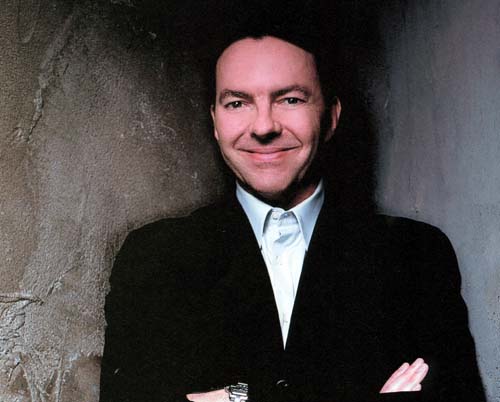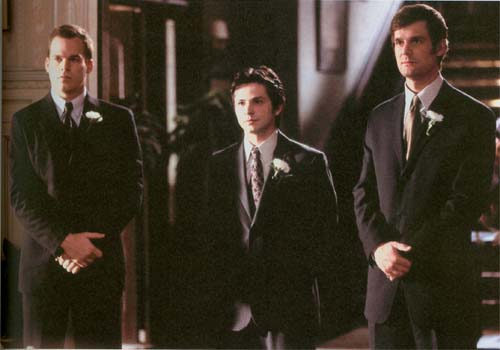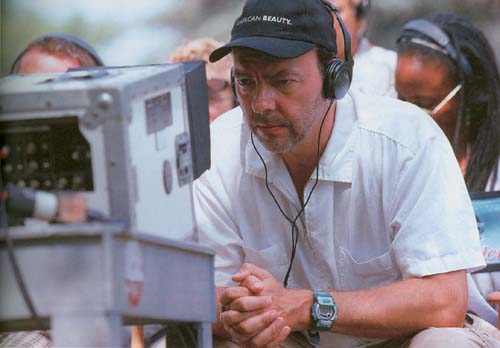
“Of all footprints, that of the elephant is supreme,” declared the Buddha in the Great Nirvana Sutra. “And of all mindfulness meditation, that on death is supreme.”
Likewise: Of all situation comedies, I Love Lucy was the greatest; but of all prime-time series about impermanence, Six Feet Under is without peer. Nothing that has appeared on the small screen can compare with this quirky meditation on attachment, mortality, and—as series creator and Executive Producer Alan Ball puts it —“life, in the constant presence of death.”
Though it makes no claims, Six Feet Under is a great example of how dharma themes are infiltrating American popular culture—without any direct Buddhist connection. Most of the show’s twelve million-plus viewers will never attend a teaching or retreat, or travel to lands where the process of dying is viewed as an opportunity for liberation. Alan Ball’s series doesn’t pretend to instruct its audience about death. It simply lifts the veil from a subject too often viewed, in our culture, through filters of fear and ignorance.
Six Feet Under premiered on HBO in 2001, two years after Ball (who’d written previously for network sitcoms) won a Best Screenplay Oscar for his astonishing American Beauty. LikeAmerican Beauty, Six Feet Under deals with themes of transformation and redemption—with a darkly comic twist.
The series takes us into the lives of the Fishers, proprietors of a family-run funeral home in Los Angeles. In the pilot, Nathaniel Fisher, the family’s patriarch, dies instantly when his new hearse is broadsided by a city bus. The Christmas Eve tragedy leaves Fisher’s four survivors—his wife, Ruth; teenage daughter, Claire; and two adult sons, Nate (a free spirit, visiting from Seattle) and David (an anxious, closeted gay)—polarized and self-protective.
The show’s foundation is the interplay of the Fishers, as each family member struggles toward the core of his or her identity amid an ever-changing caravan of corpses. Friends and lovers fill out their circle, each seeming to embody a classic obstacle (or ally) in the path to liberation. David Fisher’s companion, Keith, is a black L.A. cop with anger issues; Nate’s lover, Brenda, is a hungry ghost, plagued by an insatiable appetite for sex and sensation. Young Claire wrestles with the blithe ignorance of her high school peers. At the center of this mandala, the three-story Fisher & Sons Funeral Home is an unflinching reminder of the destination awaiting us all.
Every episode of Six Feet Under opens with a death, and with each death the Fishers, managing the burial, are given a lesson in transformation. The funeral of a Mexican gang member becomes a teaching on compassion and reconciliation; the passing of an elderly black woman leads into an exploration of True Nature. Some deaths are peaceful, some sudden, some the result of long illness. But all remind us of the fact that, as Larry Rosenberg writes in Living in the Light of Death, “No one is guaranteed even one more breath.”
After three years of devoted fandom and intense discussions with my Six Feet sangha, I felt compelled to meet the force behind this extraordinary series. Alan Ball is a tall, contemplative man whose serious eyes are balanced by a large, infectious laugh. His understated office in the Sunset Gower studios is decorated with memorabilia from American Beauty and portraits of the Six Feet Under cast. The bookshelf is stacked with texts about death and dying, including several volumes by Thomas Lynch: a poet, philosopher, and funeral director.
When American Beauty was released, much was made of the film’s Zen underpinnings—especially the scene where a simple plastic bag, dancing in a vortex of wind, is seen as a paradigm of perfection. Yet Ball, surprisingly, has no real Buddhist practice of his own.
“I’ve never been formally introduced to Buddhism,” he reflects. “It’s almost as if I have an instinctive predisposition toward it. I’m not very disciplined. I have a hard time meditating, but I keep trying to chip away at my resistance. But I do lean toward that discipline more than any other because, from what little I know of it, it seems to make the most sense.”
Ball, forty-six, was raised a Methodist in Georgia. His introduction to Buddhist sensibilities arose—like Siddhartha Gautama’s—from direct confrontation with mortality. “When I was thirteen years old,” he says, “my sister died in a car accident. It was her twenty-second birthday. She was driving me to a music lesson; I was in the car with her. That brought me face to face with tremendous loss, and the impermanence of things. I struggled for years and years with how to cope with that—and, ultimately, I started developing an innate sense of detachment.”
I ask Ball if he feels that the mere act of watching Six Feet Under can be a liberating experience, a way of coming to terms with our national denial of death.
“I would hope so,” he replies. “Working on the show has certainly been a liberating experience for me.”
“Has it helped you resolve any of your own issues regarding mortality? For your sister or for yourself?”
“It has. I was so wounded by my sister’s death that I was afraid of intimacy, of getting close to another human being, because they might die on me. So I poured myself into my work. And I was alone for many, many years. Even though I can’t possibly say that I’ve erased all my fear and anxiety about death, I’ve certainly erased any denial that it does indeed exist—and that it will happen to me.”
Ball speaks with joy and optimism about his current relationship, which represents a huge step away from his terror of loss and dissolution. His ability to love is based not on repression of the truth, he says, but on an appreciation that all committed relationships exist within the confines of mortality—and the utter certainty that they must eventually end.
The central characters on Six Feet Under mirror Ball’s growth. At the end of the first season, Nate Fisher (who suffers from severe headaches and nausea) is diagnosed with arterio-venous malformation (AVN), a mysterious disorder affecting blood vessels near the brain. Though AVN commonly goes undetected – causing little or no harm – the vessels can potentially rupture at any time, leading to a stroke or sudden death. Despite this Damoclean sword, Nate strives for deeper intimacy with his lover. The series thus becomes, for characters and viewers alike, a form of maranasati—the death-awareness contemplation studied in Theravada monasteries.
“Had I not been doing work of this nature,” Ball admits, “it would have been harder for me to face my own mortality. If the sitcom I created for ABC (Oh Grow Up) had become a hit and been syndicated for a gazillion dollars, and the main point of my life had become about being funny, I would have been less inclined to get into the muck of a meaningful life in this culture.
“My work is, for me, a spiritual discipline. I’ve been very blessed in that I’ve been given situations in which I can actually write about living life meaningfully.”
Ball’s evolution has made him one of the most celebrated screenwriters in America. I ask if his meteoric success within the Hollywood milieu has been an obstacle to his own spiritual progress.
“It’s very seductive,” he admits. “But whenever something happens to me, something else happens that puts things into perspective. The year I won the Oscar for American Beauty, I had also created Oh Grow Up, which was universally loathed and reviled. One critic said it was actually ‘painful’ to watch. One issue of People magazine listed the Best and Worst of 1999.’ On one page were the Ten Best Movies, including American Beauty. If you turned the page, they listed the Ten Worst Television Shows—and Oh Grow Up was one of them.
“I was very glad that happened. Because if you’re going to do work that’s meaningful—even if only to yourself—you have to maintain a certain level of humility and not take yourself too seriously. It’s okay to take the work seriously—but not yourself.”
In an Amazon.com interview, Ball observed, “We live in a culture that goes out of its way to deny mortality. And I think you have to have a deep and fundamental acceptance of mortality to really be able to see what’s beautiful in life – because beauty and truth are inextricably connected.”
Equating truth with mortality is an accurate view, but it’s one that many Americans don’t share. “Yet it is true,” says Ball. “We die. And to live in a culture where people have surgery to avoid looking like they’re aging, because we don’t value wisdom as much as we value young skin—well, it seems hilarious.” The absurdity is carried infinitely further, of course, when the compulsion to preserve appearances is carried into the grave. In one episode, a porn star’s sudden demise reveals the extremes of such attachment, as Federico—the funeral home’s virtuoso reconstruction artist—props up the woman’s flopping silicone breasts with cans of cat food.


Such a typically American funeral, with a body “preserved” in a box, is radically different from Asian death ceremonies. Buddhist rites often climax with cremation, or, in the case of Tibetan Buddhism, “sky burial,” a ritual in which the corpse is presented as an offering to birds and other animals. Ball, in the course of producing his show, “learned way more than I ever needed to know about what happens to bodies after we die.” He now wishes to be cremated. I ask if he’s ever seen a body burn. Indeed he has, during a trip to Bali.
“It’s interesting,” he laughs, “to look at my own karma. I run into funerals wherever I go. In the pilot episode of Six Feet Under, Nate recalls seeing a Sicilian funeral on a beach – that totally happened to me, when I was nineteen or twenty. Then there was Bali. And recently, when I went to Lebanon to visit my partner’s family, we came across the burial of the people who had died in that plane crash from Africa to Lebanon. I see a pattern there. It’s part of my work; it’s part of my karma. It’s part of what my consciousness is about.”
One of the most interesting aspects of Six Feet Under is its refusal to take a stand on the afterlife. The Fishers (or the families of the deceased) may lock horns over their individual opinions on the subject, but the show itself does not. Sometimes, though, the dead visit individual members of the Fisher family, acting as foils for their inner dialogues. At the end of the pilot episode, Nathaniel Fisher appears at his own funeral for a word with his daughter. There’s a delicious moment as, like the skeletal deity Chitipati, who dances upon charnel grounds, they chat up the benefits of being dead. Claire’s priceless remark: “No more waiting to die.”
“In the writers’ room, we envision that, when the dead speak, they’re not ghosts,” says Ball. “They are the dead person’s presence and memory and influence, in the mind of the person being spoken to.”
Ball personally believes in reincarnation, but insists that the show remain neutral. “That’s a personal choice that everyone makes,” he asserts. “It’s a mystery. It would be incorrect to have Six Feet Under say anything one way or the other.”
Confronting death and dissolution is never easy, even for monks. Most lay practitioners will never engage in extreme Buddhist practices like chöd, in which one meditates with corpses, camps in charnel grounds, or stirs up vivid images of one’s body in the process of decay. We will simply live our lives as best we can, balancing work and family with our NetFlix wish list and the occasional ten-day retreat.
The characters in Six Feet Under aren’t monks, either; they’re not even Buddhists. (Even Brenda, who surrounds herself with images of the Buddha and other protective deities, seems helpless in the face of her compulsions.) Still, their individual encounters with samvega—an urgent desire for liberation, inspired by a visceral encounters with samsara—are enormously moving and instructive. They illustrate Ball’s conviction that “for a lot of people, a life that’s filled with mistakes and tragedy and random messiness can be way more spiritual than a life of simple piety.”
At the very least, Six Feet Under demonstrates how Buddhist sensibilities are steadily entering our consciousness; so much so that, as Ball implied, they are becoming “instinctual.” It’s as if Ball himself is simply a vehicle for this process, the embodiment of a Zen koan about nondoing.
“I don’t feel like I’ve created these characters,” he states with conviction. “The show and its characters have a life of their own that is very real. Part of my job is to get out of their way and let them show me what they need to do.”
Thank you for subscribing to Tricycle! As a nonprofit, we depend on readers like you to keep Buddhist teachings and practices widely available.